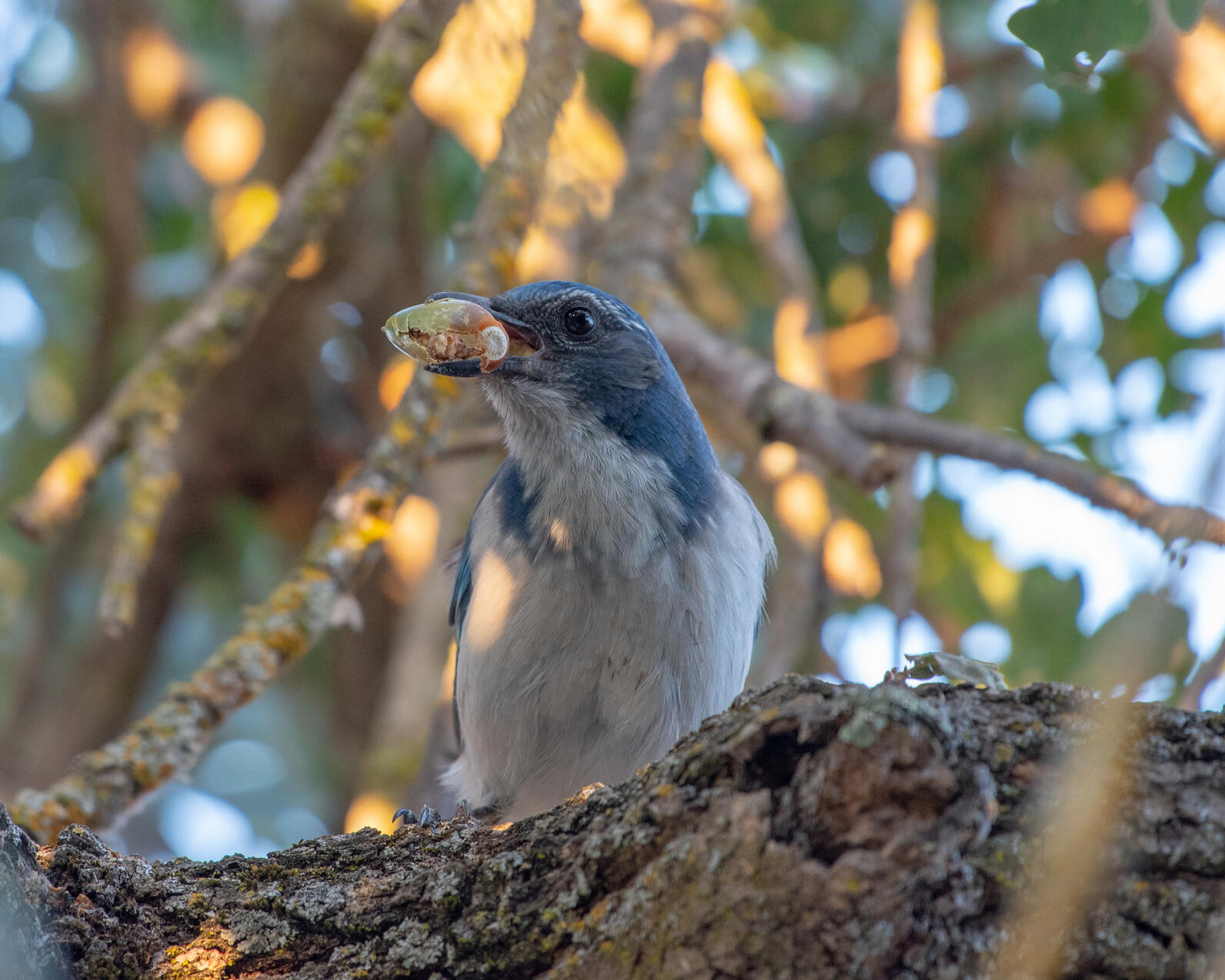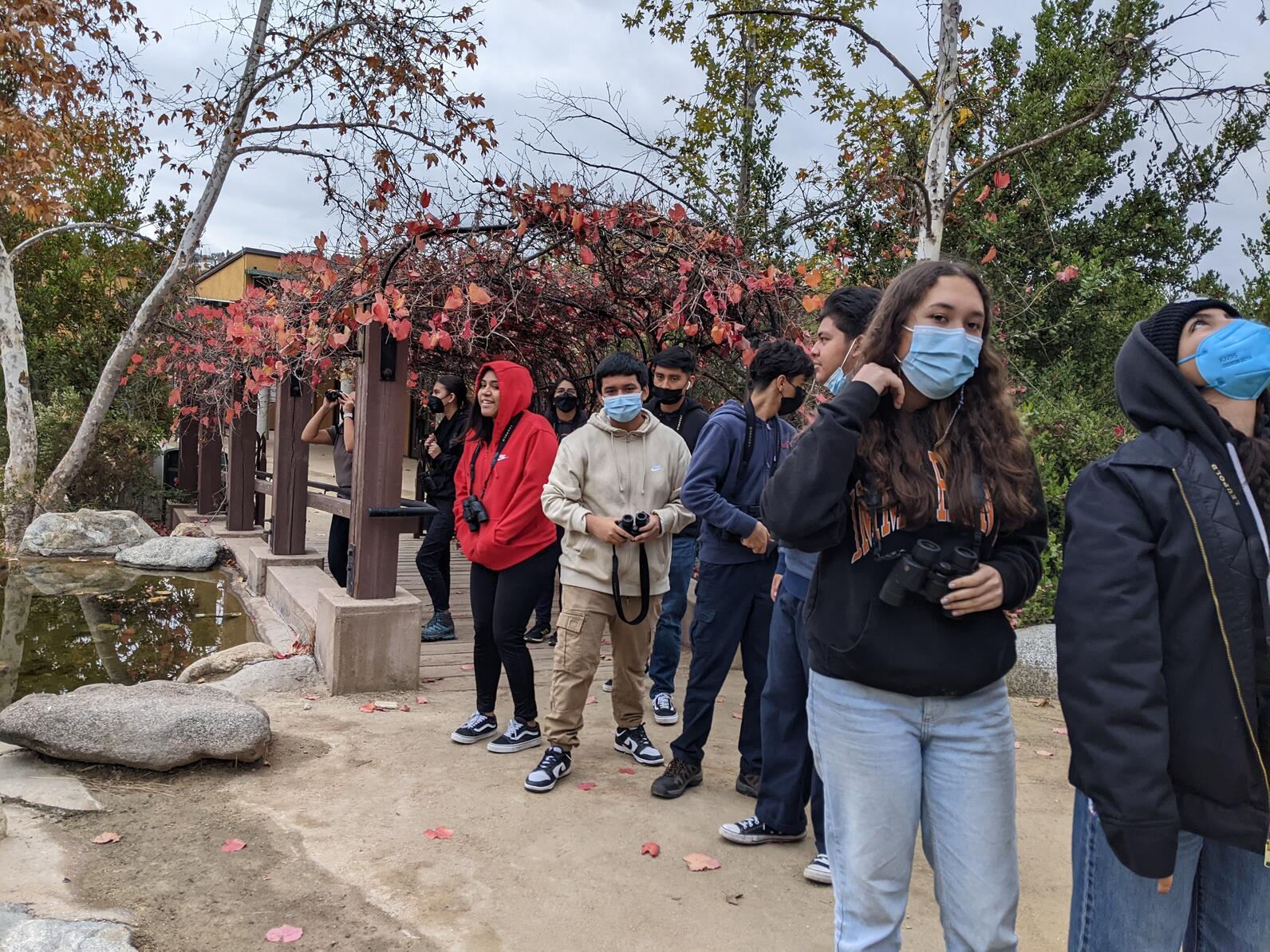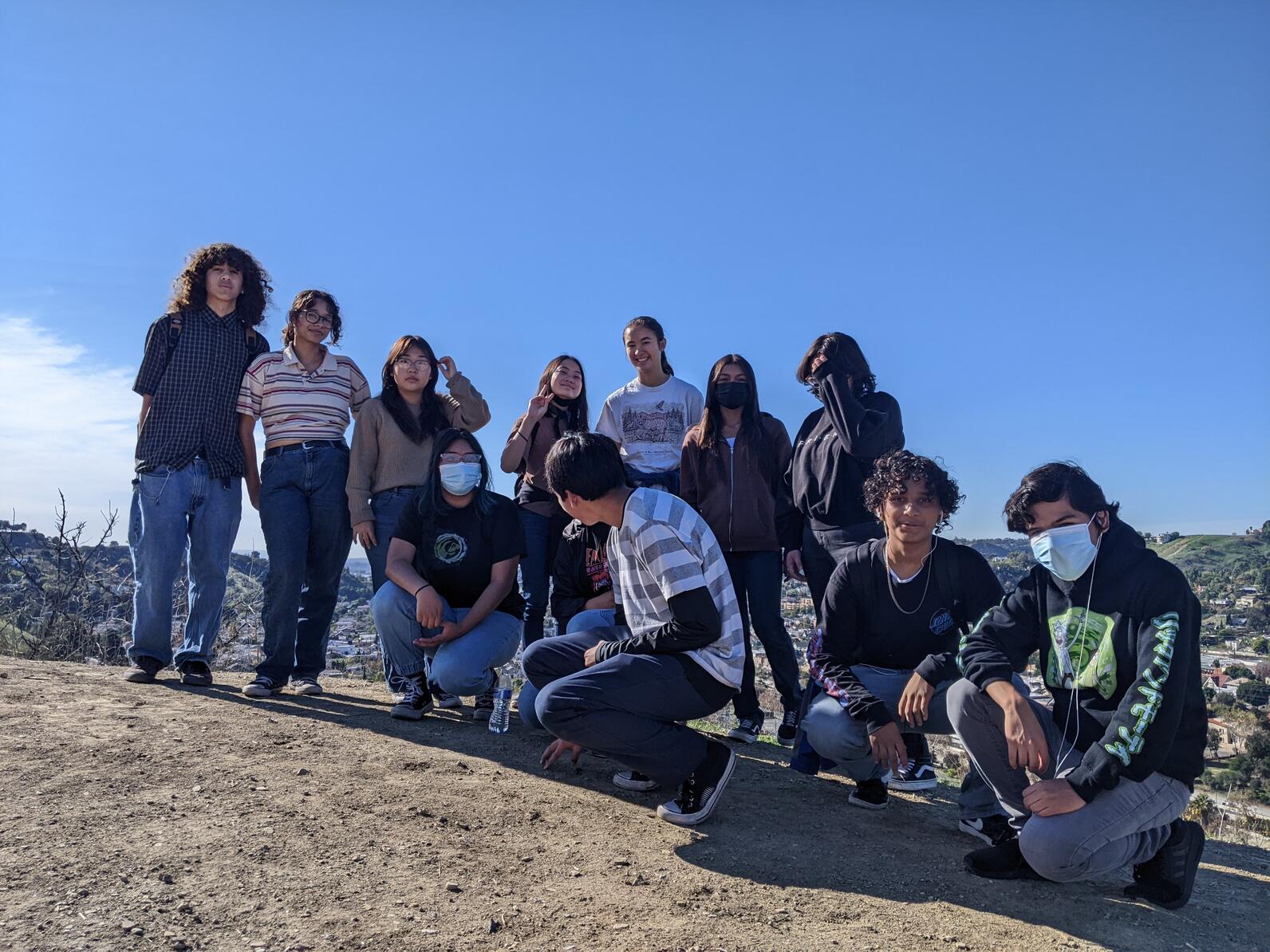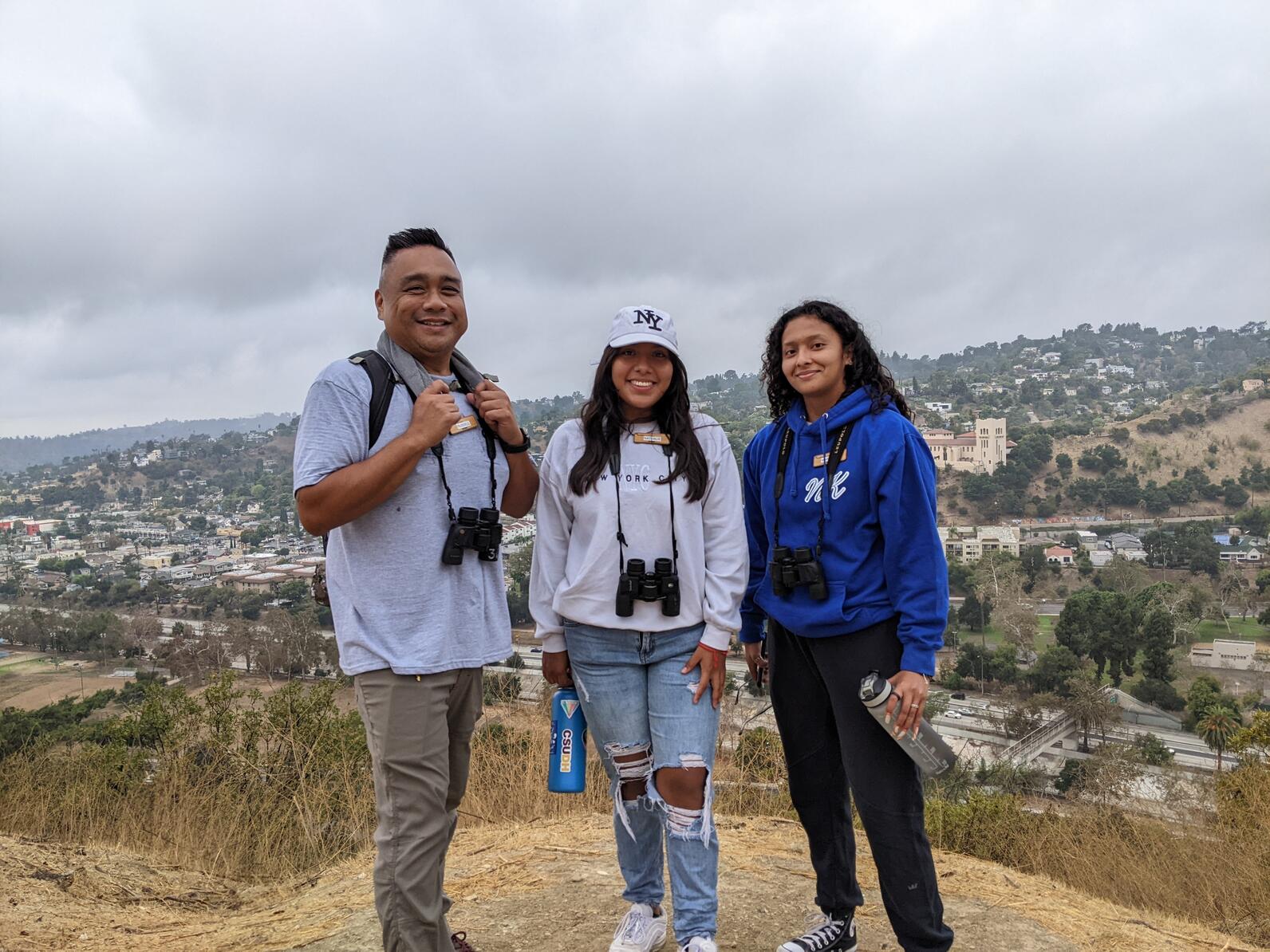
“It sounds just like this.”
“cheedle cheedle chee? cheedle cheedle chew!”
“You mean like that?”
We turned around and there it was: The Least Bell’s Vireo, perched atop an Arroyo Willow singing its song. There in the heart of Los Angeles was a federally listed endangered species, recently returned from its migration north from Southern Mexico and now staking out territory for nesting. Although surrounded by sprawling industrial and residential areas, Rio de Los Angeles State Park provides invaluable riparian habitat which the Vireo uses to nest. Threated by urbanization and habitat degradation, pockets of refuge such as Rio de Los Angeles SP are essential for the survival of this species as well as other vulnerable wildlife.
From sprawling parking lots to an expansive network of freeways fragmenting the landscape, Los Angeles may not seem like a prime wildlife viewing destination. After all, who would choose the so-called “entertainment capital of the world” as great wildlife habitat? As it turns out, Los Angeles County has some of the greatest biodiversity, or variety of life, in the United States. From mountains to beaches to deserts, the diverse ecosystems of LA County allow for a huge diversity of plants, animals and fungi. LA County also has the highest amount bird diversity over any other county in the US. Los Angeles County boasts 518 native bird species as well as 10 naturalized non-native species, like the noisy yet lovable Red-crowned parrots. These birds provide more than just aesthetic value, they provide ecosystem services that enhance humans lives as well. Sparrows and swifts help control disease-carrying mosquito populations. Scrub Jays help reforest areas by planting acorns. Hummingbirds help to pollinate plants. Raptors help to control rodent populations. Turkey Vultures help with organic waste removal and sanitation. These are just a few examples of the myriad ways that birds are an integral part of the urban landscape.
Many of our urban bird species have adapted well to life alongside their human counterparts. Rock pigeons rummaging through trash, Mallards swimming at your local park, and Crows cackling are all common sights across the city. Others however, like the Least Bell’s Vireo, are not so lucky. Urbanization and loss of habitat continues to replace natural spaces with housing and roads. City lights confuse and disorient migrating birds, who rely on stars and dark skies for navigation. Pesticide use decreases food availability for insect-eating species. Rodenticide poisons hawks and owls, who might prey on drowsy but poisoned rats and mice. Feral cats kill wild birds in disproportionately large numbers (feral cats are estimated to kill about 2.4 billion birds per year in the US alone).
But it’s not all bleak. Several organizations have rallied around our urban birds and are seeking to place protections and create habitat for them to thrive. For example, the Audubon Center at Debs Park along with its partners and volunteers have been restoring habitat for the Least Bell’s Vireo at Rio de Los Angeles State Park. A few individuals have been spotted this year, and there is hope that they will have a successful nesting season. There are also things that you can do at home that can help support urban bird populations.
Come visit us at the Audubon Center to watch urban birds, participate in habitat restoration, and learn about what else you can do to be allies with our urban birds!
Every year the Audubon Center at Debs Park celebrates urban birds in partnership with Synchromy and the Arroyo Arts Collective. If you missed our celebration you can still visit and enjoy Within::Without: Windows to an Inclusive Future, enjoy from May 13th, 2023 to June 10th, 2023.

In partnership UC ANR and Anahuacalmecac International University Preparatory of North America , the Center is offering a Climate Stewards certification to high schoolers. Anahuacalmecac is the first high school to offer this course as an approved UC A-G college prep class.
Audubon’s Public Programs Manager has helped co-construct the curriculum in partnership with Anahuacalmecac instructors, focusing on climate science lessons. The program is specifically geared towards indigenous youth and honors indigenous practices of climate stewardship in the midst of our global climate crisis.
Science lessons are hands-on and relate back to problems in the local community. After completing thecourse, students will be able to communicate and engage in local solutions to advance community and ecosystem resilience. So far, students have engaged in restoration work, mapped local areas to compare ground cover, and created their own ecosystems in jar.

We are thrilled to welcome our second cohort of Audubon Youth Leaders to the Center! 14 youth from local high schools have joined us for the program which runs from November 2022 through March 2023. Youth will complete 80 program hours total and will receive a $600 educational stipend upon completion of the program. This year, they will also receive a California Naturalist certification!
The Audubon Youth Leaders (AYL) program offers environmental leadership experience for high school aged youth. Participants will split their time between working towards their California Naturalist certifications, participating in workshops, practicing community program delivery and engaging in hands-on habitat restoration. We aim to work alongside the Youth Leaders to develop the next generation of environmental stewards and community advocates.
The current cohort has already begun the practice of nature journaling, explored Debs Park, and are developing their knowledge of local native plants and wildlife.
Stay tuned for more updates from the Youth Leaders!

The California State University Dominguez Hills (CSUDH) Toro Dreamers Success Center is collaborating with #CaliforniansForAll College Corps program and LA based organizations to provide a service-learning experience for students in the 2022-2023 calendar year. The College Corps members at the Audubon Center at Debs Park will focus on engaging the community in climate resilience through conversation and advocacy, with a focus on the importance of native plants. While onsite, they will staff our Welcome Center and engage visitors through hands-on activities. Next time you're here on a weekend, stop by the Welcome Center to say hello! Learn more about the College Corps members below:
Favorite Bird: Shoebill Stork
Favorite Past-Time: Attending live sporting events and concerts
Most Excited About: Working in the outdoors and helping restore/enhance native species + helping educate others in working towards the same thing.
Born and raised in Northern California, Russell is excited to be a part of the Audubon Center and its mission of environmental enhancement/restoration and community education and involvement. As a child, Russell collected local wildlife out of his fascination with the natural world. Luckily, his mother was not as enthusiastic about having the critters in the house and insisted he release anything he caught back to where he got it. This included frogs, snakes, lizards and insects of all kinds. Russell is currently working on his BS in Biology with an option in ecology and environmental biology at CSU Dominguez Hills. When he is not hiking, golfing or surfing, Russell enjoys going to concerts and live sports events.
Favorite Bird: Nuttall's Woodpecker
Favorite Past-Time: Running around in nature, traveling to all parts of the world, outdoor activities such as hiking, swimming, enjoying city views, and spending time with family and friends.
Most Excited About: Learning about nature and bringing this knowledge back to her community.
Nathalie is from Puebla Mexico and is currently a third year at California State University Dominguez Hills. She is majoring in Labor Studies, and hopes to work towards going to law school. She hopes to travel the world as well as she is a foodie and enjoys trying new things. She also enjoy city views and loves to be surrounded by nature. She is excited to get more knowledge on birds and then orient people on what she learned. She hopes to get her family, friends, and community involved and to introduce them to this environmental movement.
Favorite Bird: Spix’s Macaw
Favorite Past-Time: Hiking and watching basketball
Most Excited About: Getting involved with restoration work and gaining hands-on experience, as well as bringing that knowledge and experience back to her community
Marcela is excited to be involved with the Center because it brings her memories of when she was a kid and she would explore the outdoors. They have a standing tradition of going out into nature, with no signal, no electricity, and camping out once a year. This makes her feel connected with nature. Being outdoors makes her feel like she really connects with nature and plants.

In May 2020, during the global pandemic, I began to discover a new world. A unique world, the urban wildlife interface. While LA is known for buildings, I began to look more closely at the top of skylights, in the cracks of the sidewalks, and at the top of traffic lights. I started to take walks throughout the various times of the day to see the rich biodiversity in the wildlife interphase. I began to see many birds like the Cedar Waxwing, Red-tailed Hawks, Northern Flickers, and other wildlife like coyotes, gophers, and many more. I was amazed to discover this unique world in a moving city like the city of Angeles. One of my favorite things to do is urban walks around my neighborhood in Koreatown. I continue to see the types of birds present during various seasons and migration seasons. This fall season, I encourage you to walk around your neighborhood, discover the many birds that live at the top of the buildings, and hang out at traffic lights. You will be surprised to see what type of species you can find!
Although there are many buildings, the city of Los Angeles is actually a great location to go outside and look for birds.
Technically anytime during the day. However, birds are most active in the early morning. It is a good idea to go to various times of the day to see the different types of birds!
A good location where one can find birds are on the top of buildings, street lights, nearby bushes, and surrounding trees. One can go anywhere from the main downtown area to the coastal side.
October is an exhilarating month since many birds start to arrive and pass through the city of Los Angeles due to fall migration. So this October, we invite you to take the time to go outside with family and friends and find birds around the city. You will be surprised by the many types of birds you will find!
En mayo de 2020, durante la pandemia mundial, comencé a descubrir un nuevo mundo. Un mundo único, en la zona urbana, la vida silvestre que habita en la zona urbana. La ciudad de los Angeles es conocida por sus edificios, pero yo comencé a mirar más cerca las grietas de las calles, en los edificios y la parte superior de los semáforos. Empecé a caminar todas los días durante en horas distintas del día y descubrí la rica biodiversidad en la zona urbana y la vida silvestre. Empecé a ver muchas aves como el cedro encerado, el aguililla cola rojo, parpadeo del norte y otros animales salvajes como coyotes, tuzas y muchos más. Me sorprendió descubrir este mundo único en una ciudad de la ciudad de Ángeles que se mueve muy rápido. Una de mis actividades favoritas son paseos urbanos por mi vecindario/comunidad en Koreatown. Sigo estando fascinado por el tipo de aves en el transcurso del día y en las estaciones de migración. Esta temporada de otoño, les recomiendo que salgan a caminar por su vecindario/comunidad para descubrir las muchas aves que viven en la parte superior de los edificios y en los semáforos. ¡Te sorprenderás al ver qué tipo de especies puedes encontrar!
Aunque hay muchos edificios, la ciudad de Los Ángeles también es un excelente lugar para salir y buscar aves.
Técnicamente a cualquier hora del día. Sin embargo, las aves están más activas en las primeras horas de la mañana. Es una buena idea buscar a las aves a varias horas del día para ver diferentes tipos de aves.
Un buen lugar donde uno puede encontrar a las aves es en la parte superior de los edificios, señales de alto, arbustos cercanos y árboles. Uno puede ir a cualquier lugar desde el área principal del centro hasta el lado costa.
Octubre es un mes emocionante ya que muchas aves comienzan a llegar y pasar por la ciudad de Los Ángeles debido a la migración otoñal. Así que este octubre, los invitamos a que se tomen el tiempo para salir con su familia y amigos a encontrar aves alrededor de la ciudad. Te sorprenderá qué tipo de pájaros encontrarás.
Audubon Center at Debs Park is located at 4700 Griffin Ave, Los Angeles, CA 90031
Center Hours:
Trail Hours:
You can help us continue to deliver this outstanding programming to the Los Angeles area by making a generous gift today. Thank you!